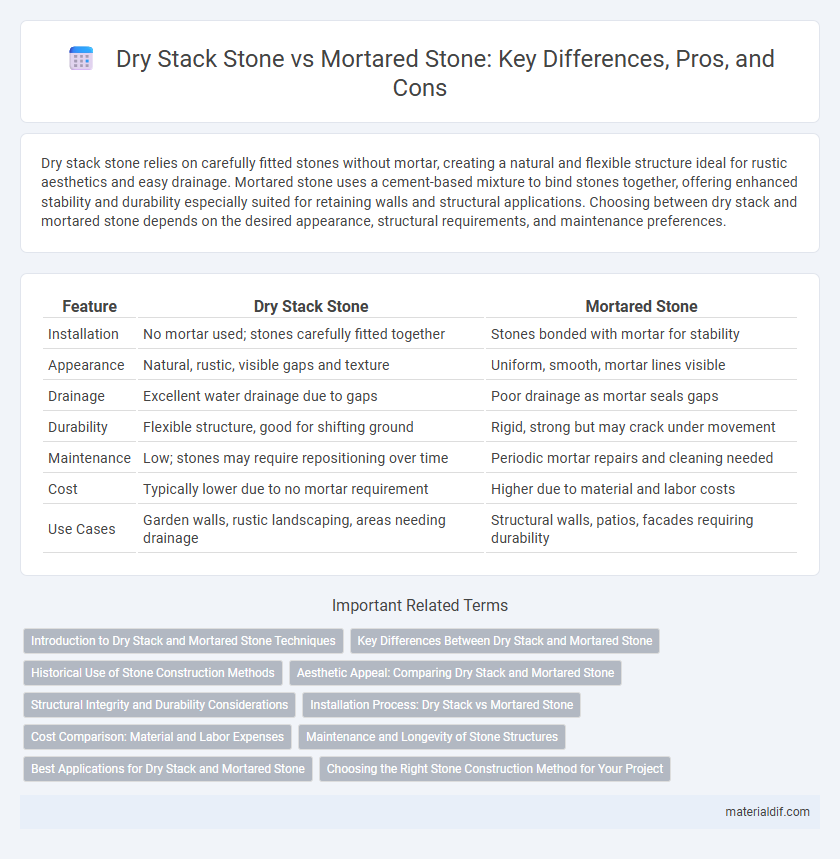Dry stack stone relies on carefully fitted stones without mortar, creating a natural and flexible structure ideal for rustic aesthetics and easy drainage. Mortared stone uses a cement-based mixture to bind stones together, offering enhanced stability and durability especially suited for retaining walls and structural applications. Choosing between dry stack and mortared stone depends on the desired appearance, structural requirements, and maintenance preferences.
Table of Comparison
| Feature | Dry Stack Stone | Mortared Stone |
|---|---|---|
| Installation | No mortar used; stones carefully fitted together | Stones bonded with mortar for stability |
| Appearance | Natural, rustic, visible gaps and texture | Uniform, smooth, mortar lines visible |
| Drainage | Excellent water drainage due to gaps | Poor drainage as mortar seals gaps |
| Durability | Flexible structure, good for shifting ground | Rigid, strong but may crack under movement |
| Maintenance | Low; stones may require repositioning over time | Periodic mortar repairs and cleaning needed |
| Cost | Typically lower due to no mortar requirement | Higher due to material and labor costs |
| Use Cases | Garden walls, rustic landscaping, areas needing drainage | Structural walls, patios, facades requiring durability |
Introduction to Dry Stack and Mortared Stone Techniques
Dry stack stone technique involves carefully fitting stones without mortar, creating a natural, interlocking structure that emphasizes the stone's texture and color while allowing for drainage and slight movement. Mortared stone technique uses a cement-based mortar to bond stones together, providing increased stability and durability in various weather conditions. Understanding these methods helps choose the right approach for landscaping, retaining walls, or architectural features based on aesthetic preferences and structural requirements.
Key Differences Between Dry Stack and Mortared Stone
Dry stack stone relies on carefully fitting stones without mortar, creating a natural, flexible structure that allows for drainage and movement. Mortared stone uses a cement-based adhesive to bond stones firmly, offering increased stability and longevity ideal for structural applications. The choice hinges on aesthetic preference, structural needs, and environmental exposure, with dry stack favored for rustic appeal and mortared stone preferred for durability.
Historical Use of Stone Construction Methods
Dry stack stone construction, characterized by precisely fitting stones without mortar, has been utilized since ancient times for building walls and fortifications due to its flexibility and drainage benefits. Mortared stone methods, involving the use of lime or cement-based mortar, became prominent in Roman architecture to provide enhanced structural stability and weather resistance. Historically, dry stack was favored in regions with abundant skilled stonemasons and seismic activity, while mortared stone enabled larger, more durable edifices like cathedrals and aqueducts.
Aesthetic Appeal: Comparing Dry Stack and Mortared Stone
Dry stack stone offers a rustic, natural aesthetic with tightly fitted stones that emphasize texture and organic patterns, creating a visually striking, artisanal appearance. Mortared stone provides a more structured and formal look, with visible joints that add uniformity and can be tailored to various styles using different mortar colors and finishes. The choice between dry stack and mortared stone significantly affects the visual impact, where dry stack emphasizes natural beauty and craftsmanship while mortared stone enhances precision and architectural refinement.
Structural Integrity and Durability Considerations
Dry stack stone walls rely on precise fitting and gravity for stability, offering flexibility that allows natural settling without cracking. Mortared stone walls use cement-based mortar to bond stones, providing enhanced structural integrity and resistance to lateral forces. In terms of durability, mortared walls typically withstand harsh weather conditions and erosion better, while dry stack walls require skilled craftsmanship to maintain long-term stability.
Installation Process: Dry Stack vs Mortared Stone
Dry stack stone installation involves carefully stacking stones without mortar, relying on precise fitting and gravity for stability, which allows for faster assembly and easier adjustments. Mortared stone requires applying a mortar mixture between stones to bind them securely, resulting in a more labor-intensive process with longer curing times but increased structural integrity. The choice between dry stack and mortared stone installation depends on project requirements for durability, aesthetics, and timeline constraints.
Cost Comparison: Material and Labor Expenses
Dry stack stone typically incurs lower material costs as it eliminates the need for mortar, relying on precisely cut stones for stability. Labor expenses can be higher for dry stack installations due to the skill required to fit stones securely without mortar, whereas mortared stone often requires less precision but involves additional costs for mortar and curing time. Overall, dry stack stone tends to be more cost-effective in materials but may balance out with labor fees compared to mortared stone.
Maintenance and Longevity of Stone Structures
Dry stack stone walls require minimal maintenance as they naturally allow for water drainage, reducing the risk of frost damage and shifting. Mortared stone structures provide enhanced stability with the binding material but demand periodic inspection and repointing to prevent mortar deterioration. Dry stack constructions typically offer longer longevity in freeze-thaw climates due to their flexibility, while mortared walls excel in structural applications where rigidity is essential.
Best Applications for Dry Stack and Mortared Stone
Dry stack stone excels in landscaping projects such as retaining walls, garden borders, and decorative features where drainage and natural appearance are key priorities. Mortared stone is best suited for structural applications like foundation walls, chimneys, and outdoor fireplaces requiring greater stability and weather resistance. Selecting dry stack for aesthetic, flexible designs preserves natural water flow, while mortared stone ensures durability in load-bearing and exposure-intensive environments.
Choosing the Right Stone Construction Method for Your Project
Dry stack stone construction offers a natural, flexible appearance with excellent drainage, making it ideal for landscaping and garden walls in areas prone to frost heave. Mortared stone provides superior structural stability and weather resistance, suitable for load-bearing walls and architectural features requiring durability. Selecting the right method depends on project requirements such as aesthetic preference, structural needs, and environmental conditions.
Dry Stack vs Mortared Stone Infographic

 materialdif.com
materialdif.com